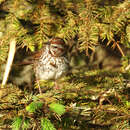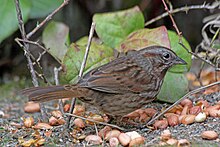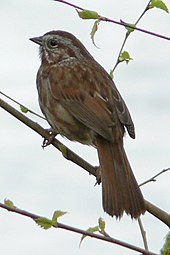en
names in breadcrumbs


Song sparrows communicate primarily through body language and vocalizations. They have a range of song and call types that communicate different states and attitudes.
Communication Channels: visual ; acoustic
Perception Channels: visual ; tactile ; acoustic ; chemical
Song sparrows are abundant in appropriate habitats throughout their range. They are protected under the U. S. Migratory Bird Treaty Act.
US Migratory Bird Act: protected
US Federal List: no special status
CITES: no special status
State of Michigan List: no special status
IUCN Red List of Threatened Species: least concern
There are no negative impacts of song sparrows on humans.
Song sparrows may disperse seeds and are important members of the ecosystems in which they live.
Song sparrows may help to disperse seeds.
Ecosystem Impact: disperses seeds
The diet of song sparrows typically consists of seeds, grains, grass, berries and, on some occasions, insects. Although song sparrows are primarily herbivorous and granivorous, during yolk formation females may consume insects or other invertebrates to supplement her diet. Since the female needs extra, high-protein food to produce her eggs, she also eats sprouting shoots and leaves, flower buds, or even algae in the spring. This new growth is known to have a higher levels of protein than old growth. Song sparrows have been reported to eat crusteaceans and mollusks in coastal areas.
Animal Foods: insects; terrestrial non-insect arthropods; mollusks; aquatic crustaceans
Plant Foods: leaves; seeds, grains, and nuts; fruit; flowers; algae
Primary Diet: herbivore (Granivore )
Song sparrows, Melospiza melodia, occurs over most of North America, with highest density population in the midwestern Great Lakes region. This is one of the most common sparrows in North America and is highly variable geographically with 39 recognized subspecies in North America and Mexico (Pyle 1997).
Biogeographic Regions: nearctic (Native )
Song sparrows are referred to as partially migratory. Permanent and summer residents inhabit breeding grounds. Song sparrows are usually found in open brushy habitats, mostly along the borders of ponds or streams, abandoned pastures, thickets or woodland edge. In winter you can find them in marshes, tall weedy fields, moist ravines and brush piles. (Ryser 1985, Rising 1984)
Habitat Regions: temperate ; terrestrial
Terrestrial Biomes: savanna or grassland ; chaparral ; forest ; scrub forest
Wetlands: marsh
Other Habitat Features: suburban ; agricultural ; riparian
Song sparrows in the wild have been known to live as long as 11 years and 4 months, though many song sparrows probably die within their first year of life.
Range lifespan
Status: wild: 11.0 (high) years.
Average lifespan
Status: wild: 136 months.
Song sparrows are mid-sized sparrows measuring between 12-17 cm. They are a monomorphic species. Song sparrows exhibit heavily streaked plumage. They are most easily recognized by dark streaks that form a central chest spot (stick pin). The head is brown with a whitish or grayish crown stripe and eye stripe. The tail is usually tinged with rusty, brown-red colored feathers, fairly long and rounded. The bill is dark brown.
Range length: 12.0 to 17.0 cm.
Other Physical Features: endothermic ; homoiothermic; bilateral symmetry
Sexual Dimorphism: sexes alike
Average mass: 19.1 g.
Average basal metabolic rate: 0.25 W.
Song sparrows are preyed upon by a number of small predators. As adults they are most likely to be preyed upon by birds of prey. As nestlings they may be eaten by snakes, raccoons, skunks, cats, weasels, and other small predators.
Song sparrows are alert and their brown, streaked coloration make them inconspicuous in the brushy habitats they occupy.
Known Predators:
Anti-predator Adaptations: cryptic
Song sparrows are known to be monogamous with occasional polygyny being observed. Males have not been reported to feed their mates. Males arrive ahead of females on the breeding grounds and begin to define their territory by puffing out their plumage, extending and fluttering their wings, and by singing from three or four main perches. Males announce their identity by territorial singing and aggressive behavior. Females announce their identity by either a high pitched note, or a nasal kind of chatter. Pair bonding occurs on the territory of the male. Females select mates, probably based on the quality of his territory. Males show readiness to mate by pouncing near their mate. They will also pounce near neighboring females while their mates are not close by. Females are more faithful to mates and reject advances of strange males while their mates come to their defense. Females will 'henpeck' their mates by opening her bill at him and giving him small pecks.
Mating System: monogamous ; polygynous
Typically all females and most males start breeding at age one. The breeding season begins in April and ends in August. Females build a nest in 5 to 10 days. The nest is made of dead grasses, weed stems, roots, and bark shreds formed into a cup with rough outer layer lined with finer grasses and sometimes hair. The nest is usually placed at the base of shrubs or clumps of grass. Females lay between 3 and 5 oval shaped, light blue or greenish-blue, spotted eggs.
Breeding interval: Song sparrows may breed once or twice during a breeding season.
Breeding season: Song sparrows breed from April through August.
Range eggs per season: 3.0 to 5.0.
Range time to hatching: 12 to 14.0 days.
Range time to independence: 18 to 20 days.
Average age at sexual or reproductive maturity (female): 1.0 years.
Average age at sexual or reproductive maturity (male): 1.0 years.
Key Reproductive Features: iteroparous ; seasonal breeding ; gonochoric/gonochoristic/dioecious (sexes separate); sexual ; fertilization ; oviparous
Average eggs per season: 4.
Females incubate the eggs for 12 to 14 days. The young are tended by both male and female for the first 5 to 6 days, although females are more commonly observed at the nest. The young open their eyes at 3 to 4 days, they can fly well at 17 days, and are independent at 18 to 20 days.
Parental Investment: altricial ; pre-fertilization (Provisioning, Protecting: Male, Female); pre-hatching/birth (Provisioning: Female, Protecting: Male, Female); pre-weaning/fledging (Provisioning: Male, Female, Protecting: Male, Female); pre-independence (Provisioning: Male, Female, Protecting: Male, Female)
The song sparrow (Melospiza melodia) is a medium-sized New World sparrow. Among the native sparrows in North America, it is easily one of the most abundant, variable and adaptable species.

Adult song sparrows have brown upperparts with dark streaks on the back and are white underneath with dark streaking and a dark brown spot in the middle of the breast. They have a brown cap and a long brown rounded tail. Their face is gray with a brown streak through each eye. They are highly variable in size across numerous subspecies (for subspecies details, see below). The body length ranges from 11 to 18 cm (4.3 to 7.1 in) and wingspan can range from 18 to 25.4 cm (7.1 to 10.0 in).[2][3] Body mass ranges from 11.9 to 53 g (0.42 to 1.87 oz).[4] The average of all races is 32 g (1.1 oz) but the widespread nominate subspecies (M. m. melodia) weighs only about 22 g (0.78 oz) on average. The maximum lifespan in the wild is 11.3 years.[5] The eggs of the song sparrow are brown with greenish-white spots. Females lay three to five eggs per clutch, with an average incubation time of 13–15 days before hatching.
In the field, they are most easily confused with the Lincoln's sparrow and the Savannah sparrow. The former can be recognized by its shorter, grayer tail and the differently-patterned head, the brown cheeks forming a clear-cut angular patch. The Savannah sparrow has a forked tail and yellowish flecks on the face when seen up close.
Though a habitat generalist, the song sparrow favors brushland and marshes, including salt marshes across most of Canada and the United States. They also thrive in human dominated areas such as in suburbs, agricultural fields, and along roadsides. Permanent residents of the southern half of their range, northern populations of the song sparrow migrate to the southern United States or Mexico during winter and intermingle with the native, non-migratory population. The song sparrow is a very rare vagrant to western Europe, with a few recorded in Great Britain and Norway.
These birds forage on the ground, in shrubs or in very shallow water. They mainly eat insects and seeds. Birds in salt marshes may also eat small crustaceans. They nest either in a sheltered location on the ground or in trees or shrubs. Song sparrows with areas of shrub cover in their territory, away from the intertidal coastline, have greater over-winter survival, as well as higher reproductive success.[6]
The song sparrow has been the subject of several studies detailing the physiological reactions of bird species to conditions such as daylight length and differing climatic conditions. Most birds gain mass in their reproductive organs in response to some signal, either internal or external as the breeding season approaches. The exact source of this signal varies from species to species - for some, it is an endogenous process separate from environmental cues, while other species require extensive external signals of changing daylight length and temperature before beginning to increase the mass of their reproductive organs. Male specimens of M. melodia gain significant testicular mass in response both to changes in the daily photoperiod and as a result of endogenous chemical signals.[7] Females also undergo significant ovarian growth in response to both photo-period and endogenous signals. Hormone levels in both males and females fluctuate throughout the breeding season, having very high levels in March and late April and then declining until May.[8] These studies suggest that there are multiple factors at work that influence when and how the song sparrow breeds other than just increasing day length.
Due to the myriad subspecies of the song sparrow and the extremely varied climate of southern California, where many of these subspecies make their homes, physiological studies were undertaken to determine how climatic conditions and local environment influenced the bill size of M. melodia subspecies. The bill of a bird is highly important for thermoregulation as the bare surface area makes a perfect place to radiate excess heat or absorb solar energy to maintain homeostasis.[9] Knowing this, comparisons of bill length between individual song sparrows collected in different habitats were made with regard to the primary habitat type or microclimate that they were collected in. Larger beaked subspecies were strongly correlated with hotter microclimates - a correlation that follows from the conditions of Allen's Rule.[10]

The sparrow species derives its name from its colorful repertoire of songs. Enthusiasts report that one of the songs heard often in suburban locations closely resembles the opening four notes of Ludwig van Beethoven's Symphony No. 5. The male uses a fairly complex song to declare ownership of its territory and attract females.
Singing itself consists of a combination of repeated notes, quickly passing isolated notes, and trills. The songs are very crisp, clear, and precise, making them easily distinguishable by human ears. A particular song is determined not only by pitch and rhythm but also by the timbre of the trills. Although one bird will know many songs—as many as 20 different tunes with as many as 1000 improvised variations on the basic theme,—unlike thrushes, the song sparrow usually repeats the same song many times before switching to a different song.
Song sparrows typically learn their songs from a handful of other birds that have neighboring territories. They are most likely to learn songs that are shared between these neighbors. Ultimately, they will choose a territory close to or replacing the birds that they have learned from. This allows the song sparrows to address their neighbors with songs shared with those neighbors. It has been demonstrated that song sparrows are able to distinguish neighbors from strangers on the basis of song, and also that females are able to distinguish (and prefer) their mate's songs from those of other neighboring birds, and they prefer songs of neighboring birds to those of strangers.[11]
A 2022 study by Duke University also found that male song sparrows memorize a 30-minute long playlist of their songs and use that information to curate both their current playlist and the following one. The findings suggest that male song sparrows deliberately shuffle and repeat their songs possibly to keep a female's attention.[12]
Common predators of the song sparrow include cats, hawks, and owls, however snakes, dogs, and the American kestrel are treated ambiguously, suggesting that they are less of a threat. The song sparrow recognizes enemies by both instinctual and learned patterns (including cultural learning), and adjusts its future behavior based on both its own experiences in encounters, and from watching other birds interact with the enemies. Comparisons of experiments on hand-raised birds to observation of birds in the wild suggest that the fear of owls and hawks is instinctual, but fear of cats is learned.[13]
Song sparrows' nests are parasitized by the brown-headed cowbird. The cowbirds' eggs closely resemble song sparrows' eggs, although the cowbirds' eggs are slightly larger. Song sparrows recognize cowbirds as a threat and attack the cowbirds when they are near the nest. There is some evidence that this behavior is learned rather than instinctual.[13] A more recent study found that the behavior of attacking female cowbirds near nests may actually attract cowbird parasitism because the female cowbirds use such behavior to identify female song sparrows that are more likely to successfully raise a cowbird chick.[14] One study found that while cowbird parasitism did result in more nest failure, overall there were negligible effects on song sparrow populations when cowbirds were introduced to an island. The study pointed to a number of explanatory factors including song sparrows raising multiple broods, and song sparrows' abilities to raise cowbird chicks with their own.[15]
The song sparrow is one of the most polytypic bird species in North America, rivaling other variable species on a global scale, such as the horned lark, the yellow wagtail, the golden whistler, and the island thrush. There have been a total of 52 subspecies named altogether, of which 25 are still recognized following a systematic morphological review.[16] A high quality reference genome has recently been created for this species, which will allow for comprehensive genomic analyses of the differences between the several morphologically diverged subspecies.[17]
Small, brownish, long-winged forms with strong black streaks.
Large, dark, diffuse dark streaks. A study of mtDNA allozyme variation of most forms in this group concluded that they are of comparatively recent origin and that island populations are apparently derived independently from each other.[18]


Small, well-marked and short-winged brownish forms. All resident, except occasional birds from upland populations.
Small, pale, streaks rufous; all resident.
Black-spotted, white throats; all resident.
Seen as a whole, the song sparrow is widespread and common enough to be classified as Species of Least Concern by the IUCN. The taxa mailliardi, maxillaris, samuelis (all Category 3), pusillula (Category 2), and graminea (Category 1) are listed as Species of Special Concern in California.[21]
{{cite journal}}: CS1 maint: multiple names: authors list (link) The song sparrow (Melospiza melodia) is a medium-sized New World sparrow. Among the native sparrows in North America, it is easily one of the most abundant, variable and adaptable species.